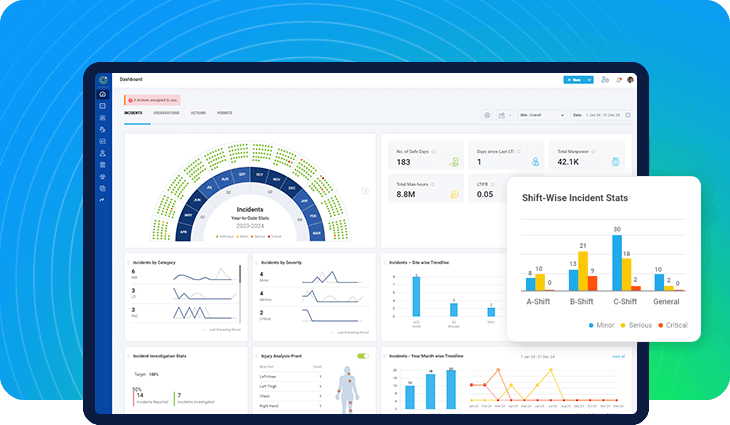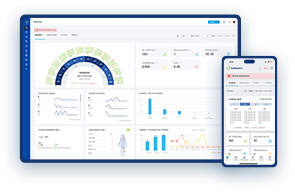
Why LTIFR Matters For Workplace Safety
Have you ever wondered how to measure workplace safety effectively? Lost Time Injury Frequency Rate (LTIFR) is a crucial metric that helps organizations track and improve safety performance.
By understanding and utilizing LTIFR, you can create a safer work environment and ensure the well-being of your employees.
LTIFR offers a clear picture of your organization’s safety standards, allowing you to identify areas for improvement. In this blog post, we will take you through the essentials of LTIFR, from calculation methods to strategies for improvement.
Let’s dive right in.
What is LTIFR?
Lost Time Injury Frequency Rate (LTIFR) is a safety metric used to measure the number of lost time injuries (LTIs) that occur per one million hours worked. LTIs are incidents that result in an employee being unable to work for a period of time due to injury. LTIFR helps organizations understand how often these injuries occur, providing a clear indicator of workplace safety.
A lower LTIFR suggests a safer work environment, while a higher LTIFR indicates a need for improvement in safety measures. This metric is essential for tracking safety performance, identifying trends, and implementing strategies to enhance employee safety.
LTIFR is a vital indicator of workplace safety. It helps measure safety performance, track the effectiveness of safety programs, and identify trends in workplace injuries. By regularly monitoring LTIFR, organizations can benchmark their safety performance against industry standards and enhance their compliance with regulatory requirements. This proactive approach not only improves safety outcomes but also boosts employee morale and reduces costs associated with workplace injuries.
Several factors can impact LTIFR, including the work environment, safety protocols, employee training, and incident reporting. A safe and well-maintained workplace reduces the risk of injuries. Clear and enforced safety procedures help prevent accidents. Proper training ensures employees know how to work safely, and timely, accurate incident reporting helps manage and mitigate risks.
How to Calculate LTIFR
Calculating LTIFR is straightforward. Use the following formula:
For example, if your organization has 5 LTIs in a year and your employees worked a total of 2,000,000 hours, your LTIFR would be
This means there are 2.5 lost time injuries per million hours worked.
Strategies and Challenges in Managing LTFIR
Managing LTIFR involves both implementing strategies to improve safety and overcoming challenges that may arise. Here are some key points to consider:
Implement Safety Programs: Develop comprehensive safety initiatives tailored to your organization’s needs.
Enhance Training: Regular and effective training for all employees is crucial. Consistent training keeps safety practices up-to-date and engaging.
Use Technology: Adopt safety management software for better tracking and analysis. Accurate reporting ensures all incidents are correctly recorded, which is essential for reliable LTIFR data.
Conduct Audits: Regular safety audits help identify and address potential hazards. Building a strong safety culture promotes ongoing awareness and commitment to safety protocols.
LTIFR vs. TRIR: Understanding the Differences
LTIFR and TRIR (Total Recordable Incident Rate) are both safety metrics but differ in scope. LTIFR measures only lost time injuries, while TRIR includes all recordable incidents, not just those resulting in lost time. Understanding both metrics helps provide a complete picture of workplace safety and allows organizations to tailor their safety programs accordingly.
Tools and Resources for LTIFR Management

Utilizing tools and resources can significantly aid in managing LTIFR. EHS software, like Safetymint, offers comprehensive tracking and reporting capabilities. Best practices and industry standards provide guidelines for maintaining low LTIFR. Additionally, training materials and resources support ongoing employee education and safety awareness.
Take a free trial of Safetymint
Understanding and managing LTIFR is crucial for workplace safety. By implementing effective strategies and utilizing the right tools, organizations can reduce injuries, improve safety performance, and create a safer work environment for all employees.

Ramesh Nair is the Founder and Principal Partner of Niyati Technologies, the company behind Safetymint.
He’s a dedicated advocate for workplace safety. Ramesh firmly believes that every individual deserves to return home safely after a day’s work. Safetymint, the innovative safety management software, emerged from this conviction. It’s a platform designed to streamline safety management, empower safety professionals, and enhance safety in workplaces.
Through his blog, Ramesh shares insights, best practices, and innovative solutions for workplace safety. Visit his social media profiles to follow him for regular updates.




